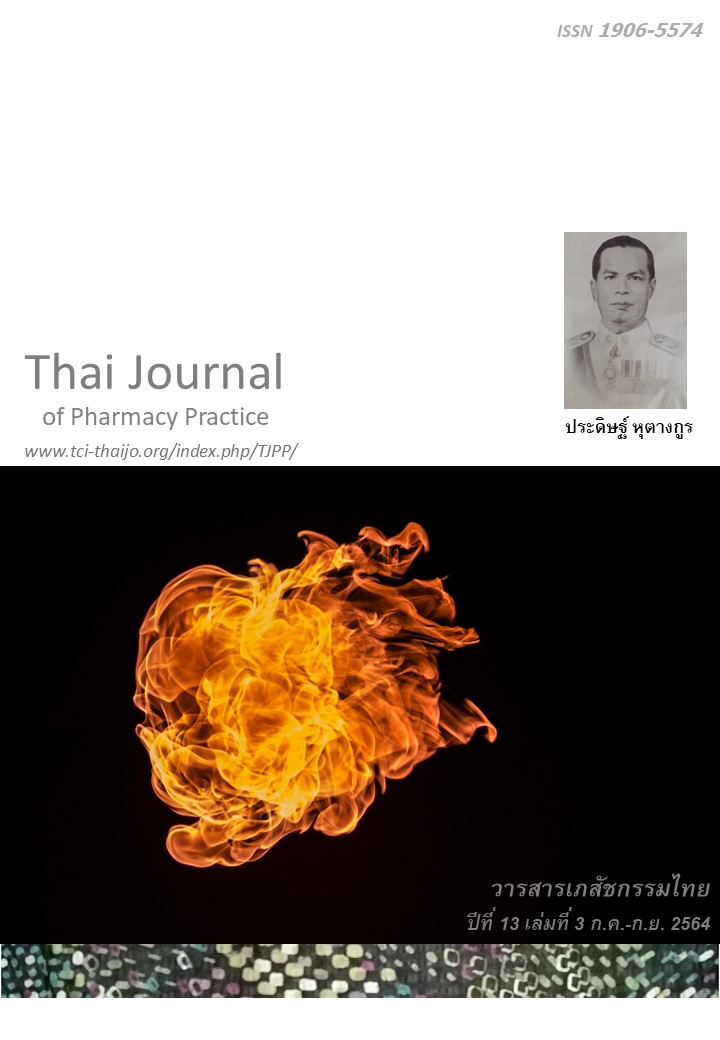ผลลัพธ์ที่เกี่ยวข้องกับผู้ป่วยและค่ายาที่เกิดขึ้นของการปรับเปลี่ยนวิธีบริหารยาต้านจุลชีพกลุ่มฟลูออโรควิโนโลนจากยาฉีดเข้าทางหลอดเลือดดำเป็นยารับประทานในผู้ป่วยผู้ใหญ่
Main Article Content
บทคัดย่อ
วัตถุประสงค์: เพื่อศึกษาผลลัพธ์เรื่องระยะเวลาการได้รับยาฉีด ระยะเวลาการรักษาตัวในโรงพยาบาล และค่ายาต้านจุลชีพของการปรับเปลี่ยนวิธีบริหารยาต้านจุลชีพกลุ่มฟลูออโรควิโนโลนจากยาฉีดเข้าทางหลอดเลือดดำเป็นยารับประทาน วิธีการ: การศึกษาเก็บข้อมูลย้อนหลังจากเวชระเบียนผู้ป่วยในโรงพยาบาลศิริราช ระหว่างเดือนมกราคม ถึง เดือนธันวาคม พ.ศ. 2561 ตัวอย่าง คือ ผู้ป่วยในอายุตั้งแต่ 18 ปีขึ้นไปที่ได้รับยาต้านจุลชีพกลุ่มฟลูออโรควิโนโลนรูปแบบฉีดเข้าทางหลอดเลือดดำชนิดใดชนิดหนึ่งใน 3 ชนิด ได้แก่ levofloxacin ciprofloxacin และ moxifloxacin ผู้ที่ผ่านเกณฑ์คัดเข้าและออกที่กำหนด ถูกสุ่มเลือกแบบเป็นระบบออกเป็น 2 กลุ่ม คือ กลุ่มที่ปรับเปลี่ยนวิธีบริหารยา (conversion group: CON) และกลุ่มที่ไม่ปรับเปลี่ยนวิธีบริหารยา (non-conversion group: NCON) การศึกษาเปรียบเทียบผลลัพธ์และค่ายาระหว่าง 2 กลุ่ม ผลการวิจัย: ผู้ป่วย 360 ราย แบ่งเป็นกลุ่ม CON และกลุ่ม NCON 157 ราย และ 203 ราย ตามลำดับ อัตราการปรับเปลี่ยนวิธีบริหารยา คือ ร้อยละ 43.6 กลุ่ม CON มีค่ามัธยฐานของระยะเวลาการได้รับยาฉีดน้อยกว่ากลุ่ม NCON คือ 4 วัน และ 8 วัน ตามลำดับ (P<0.001) มีค่า มัธยฐานของระยะเวลาการรักษาตัวในโรงพยาบาลน้อยกว่ากลุ่ม NCON คือ 10 และ 28 วัน ตามลำดับ (P<0.001) และมีค่า มัธยฐานของค่ายาต้านจุลชีพทั้งหมดน้อยกว่ากลุ่ม NCON คือ 1,876 และ 3,105 บาท ตามลำดับ (P<0.001) สรุป: อัตราการปรับเปลี่ยนวิธีบริหารยากลุ่มฟลูออโรควิโนโลนค่อนข้างต่ำ อย่างไรก็ตาม กลุ่ม CON สามารถลดระยะเวลาการได้รับยาฉีด ระยะเวลาการรักษาตัวในโรงพยาบาล และลดค่ายาต้านจุลชีพลงได้อย่างมีนัยสำคัญทางสถิติ
Article Details
ผลการวิจัยและความคิดเห็นที่ปรากฏในบทความถือเป็นความคิดเห็นและอยู่ในความรับผิดชอบของผู้นิพนธ์ มิใช่ความเห็นหรือความรับผิดชอบของกองบรรณาธิการ หรือคณะเภสัชศาสตร์ มหาวิทยาลัยสงขลานครินทร์ ทั้งนี้ไม่รวมความผิดพลาดอันเกิดจากการพิมพ์ บทความที่ได้รับการเผยแพร่โดยวารสารเภสัชกรรมไทยถือเป็นสิทธิ์ของวารสารฯ
เอกสารอ้างอิง
Sumpradit N, Suttajit S, Poolpolsup S, Chuanchuen R, Prakongsai P. Lanscape of antimicrobial resistance situation and action in Thailand. Nonthaburi: Bureau of Drug Control; 2015.
Apisarnthanarak A, Danchaivijitr S, Khawcharoen porn T, Limsrivilai J, Warachan B, Bailey TC, et al. Effectiveness of education and an antibiotic-control program in a tertiary care hospital in Thailand. Clin Infect Dis. 2006; 42: 768-75.
Thamlikitkul V, Apisitwittaya W. Implementation of clinical practice guidelines for upper respiratory infection in Thailand. Int J Infect Dis. 2004; 8: 47-51.
Dellit TH, Owens RC, McGowan JE, Gerding DN, Weinstein RA, Burke JP, et al. Infectious Diseases Society of America and the Society for Healthcare Epidemiology of America Guidelines for Developing an Institutional Program to Enhance Antimicrobial Stewardship. Clin Infect Dis. 2007; 44: 159-77.
Barlam TF, Cosgrove SE, Abbo LM, MacDougall C, Schuetz AN, Septimus EJ, et al. Implementing an Antibiotic Stewardship Program: Guidelines by the Infectious Diseases Society of America and the Society for Healthcare Epidemiology of America. Clin Infect Dis. 2016; 62: 51-77.
Ministry of Public Health. Thailand national strategic plan on antimicrobial resistance 2017-2021 [online]. 2017 [cited Jul 25, 2020]. Available from: www.fda. moph.go.th/sites/drug/Shared%20Documents/AMR/ 04.pdf.
Cyriac JM, James E. Switch over from intravenous
to oral therapy: A concise overview. J Pharmacol
Pharmacother. 2014; 5: 83-7.
Centers for Disease Control and Prevention. The core elements of hospital antibiotic stewardship programs [online]. 2019 [cited Jul 25, 2020]. Available from: www.cdc.gov/antibiotic-use/healthcare/pdfs/hospital-core-elements-H.pdf.
Rattanaumpawan P. Antimicrobial stewardship in hospitals. Bangkok: Siriraj Academic Affairs; 2018.
Cunha CB. Antimicrobial stewardship program pers pective: iv-to-po switch therapy. R I Med J 2018; 101 : 31-4.
Beyene Berha A, Kassie GM. Current practice and barriers to an early antimicrobial conversion from intravenous to oral among hospitalized patients at Jimma University Specialized Hospital: prospective observational study. Interdiscip Perspect Infect Dis. 2019; 2019: 7847354. doi: 10.1155/2019/7847354.
Belforti RK, Lagu T, Haessler S, Lindenauer PK, Pekow PS, Priya A, et al. Association between initial route of fluoroquinolone administration and outcomes in patients hospitalized for community-acquired pneumonia. Clin Infect Dis. 2016; 63: 1-9.
Park SM, Kim HS, Jeong YM, Lee JH, Lee E, Lee E, et al. Impact of intervention by an antimicrobial stewardship team on conversion from intravenous to oral fluoroquinolones. J Infect Chemother. 2017; 49: 31-7.
Shrayteh ZM, Rahal MK, Malaeb DN. Practice of switch from intravenous to oral antibiotics. Springerplus. 2014; 3: 717. doi: 10.1186/2193-1801-3-717.
National Antimicrobial Resistance Surveillance Center Thailand (NARST). Antimicrobial resistance 2000-2019 [online]. 2019 [cited Jul 24, 2020]. Available from: narst.dmsc.moph.go.th/data/AMR%2 02000-2019-12M.pdf.
Lautenbach E, Larosa LA, Kasbekar N, Peng HP, Maniglia RJ, Fishman NO. Fluoroquinolone utilization in the emergency departments of academic medical centers: prevalence of, and risk factors for, inappropriate use. Arch Intern Med. 2003; 163: 601-5.
Méan M, Pavese P, P Vittoz J, Foroni L, Decouchon C, Stahl JP, et al. Prospective assessment of fluoroquinolone use in a teaching hospital. Clin Microbiol Infect. 2006; 25: 757-63.
Werner NL, Hecker MT, Sethi AK, Donskey CJ. Unnecessary use of fluoroquinolone antibiotics in hospitalized patients. BMC Infect Dis. 2011; 11:187. doi: 10.1186/1471-2334-11-187.
Rose L. Future of fluoroquinolones: Benefits of antibiotic workhorse [online]. 2019 [cited Jul 27, 2020]. Available from: www.contagionlive.com/publi cations/contagion/2019/april/future-of-fluoroquinolon es-risks-benefits-of-antibiotic-workhorse.
Venditti M. Definitions and challenges in every-day-practice: how to establish that an infection is healthcare associated [online]. 2009 [cited Jul 26, 2020]. Available from: www.who.int/gpsc/informati on_centre/venditti-mario.pdf?ua=1.
Lefkovitz A. Focus on converting from iv to po antibiotic therapy [online]. 2016 [cited June 23, 2020]. Available from: www.omnicare.com/media /10 93/4_iv_to_po_antibiotic_therapy.pdf.
Gauthier TP. A resource to help with changing from iv to po antibiotics [online]. Promoting clinical pharmacy and antimicrobial stewardship. 2018 [cited May 28, 2019]. Available from: www.idstewardship .com /resource-help-changing-iv-po-antibiotics/.
Wetzstein GA. Intravenous to oral (iv:po) anti-infective conversion therapy. Cancer control. 2000; 7: 170-6.
Nathwani D, Tillotson G, Davey P. Sequential antimicrobial therapy--the role of quinolones. J Antimicrob Chemother. 1997; 39: 441-6.
Laing RB, Mackenzie AR, Shaw H, Gould IM, Douglas JG. The effect of intravenous-to-oral switch guidelines on the use of parenteral antimicrobials in medical wards. J Antimicrob Chemother. 1998; 42: 107-11.
McLaughlin CM, Bodasing N, Boyter AC, Fenelon C, Fox JG, Seaton RA. Pharmacy-implemented guidelines on switching from intravenous to oral antibiotics: an intervention study. QJM. 2005; 98: 745-52.
Mertz D, Koller M, Haller P, Lampert ML, Plagge H, Hug B, et al. Outcomes of early switching from intravenous to oral antibiotics on medical wards. J Antimicrob Chemother. 2009; 64: 188-99.
Buyle F, Vogelaers D, Peleman R, Van Maele G, Robays H. Implementation of guidelines for sequential therapy with fluoroquinolones in a Belgian hospital. Pharm World Sci. 2010; 32: 404-10.
Sze WT, Kong MC. Impact of printed antimicrobial stewardship recommendations on early intravenous to oral antibiotics switch practice in district hospitals. Pharm Pract (Granada). 2018; 16: 1-6.
Dunn AS, Peterson KL, Schechter CB, Rabito P, Gotlin AD, Smith LG. The utility of an in-hospital observation period after discontinuing intravenous antibiotics. Am J Med. 1999; 106: 6-10.
Boyter AC, Stephen J, Fegan PG, Nathwani D. Why do patients with infection remain in hospital once changed to oral antibiotics?. J Antimicrob Chemother. 1997; 39: 286-8.
van Niekerk AC, Venter DJ, Boschmans SA. Implementation of intravenous to oral antibiotic switch therapy guidelines in the general medical wards of a tertiary-level hospital in South Africa. J Antimicrob Chemother. 2012; 67: 756-62.


